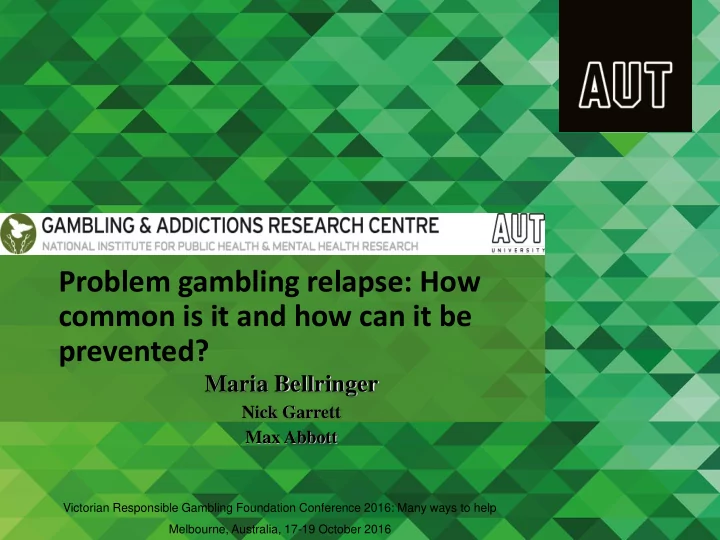

Problem gambling relapse: How common is it and how can it be prevented? Maria Bellringer Nick Garrett Max Abbott Victorian Responsible Gambling Foundation Conference 2016: Many ways to help Melbourne, Australia, 17-19 October 2016
Today’s presentation • Data from New Zealand National Gambling Study (2012 – 2013) • Transitions into and out of at-risk gambling • Prevalence of moderate-risk and problem gambling • Incidence of moderate-risk and problem gambling • Relapse into moderate-risk/problem gambling • Data from NZ treatment provider database (2012 – 2013) • Relapse of people attending face-to-face services
The NZ National Gambling Study
The NZ National Gambling Study • Nationally representative prevalence survey • Face-to-face interviews • Adults aged 18+ years
Sample size Wave 1 (2012) N=6,251 Attempted 12-month No 12-month follow-up follow-up (2013) attempt (2013) n=5,266 n=985 Wave 2 did not Wave 2 participated participate n=1,521 n=3,745
Transitions from Wave 1 to Wave 2 Wave 2 Non- Moderate- Non- problem Low-risk risk Problem gambler gambler gambler gambler gambler Wave 1 n % n % n % n % n % Total Non-gambler 485 64.7 247 33.0 16 2.1 1 0.1 <1 0.1 748 Non-problem 327 11.9 2267 82.5 133 4.8 19 0.7 3 0.1 2749 gambler Low-risk gambler 13 7.2 97 54.6 46 25.7 21 11.7 1 0.8 178 Moderate-risk 4 6.9 16 30.7 14 25.3 15 27.5 5 9.6 53 gambler Problem gambler 0 0.0 6 32.6 2 13.6 2 9.7 7 44.1 17 Total 828 22.1 2633 70.3 210 5.6 57 1.5 18 0.5 3746 No change Transition to a higher risk level Transition to a lower risk level
Incidence and prevalence • Prevalence refers to the percentage of the population with problem gambling at any given point in time • Incidence refers to the number of new cases of problem gambling occurring in a population in a given time period.
Incidence and prevalence • 10 participants became problem gamblers between Wave 1 and Wave 2 • Incidence of 0.28% (CI 0.10 - 0.45) • Nationally, about 8,046 people (CI 2,874 - 12,931) • 0.5% problem gambling prevalence
Relapse • Relapse is not uncommon among gamblers trying to reduce or quit gambling • But how common is relapse? What are the implications for treatment provision?
Measuring relapse • Wave 2 moderate-risk and problem gamblers • Who were not this in Wave 1 • But who had problems with gambling some time in the past
Relapse to moderate-risk/problem gambling n=11.6, 26% Relapse cases Non-relapse n=34.0, 74% 26% of ‘new’ moderate -risk/problem gamblers had RELAPSED from past problematic gambling 48% of ‘new’ problem gamblers had RELAPSED from past problematic gambling
Limitations and considerations • Small numbers relapsed to moderate-risk/problem gambling (n=46) • Relapse measured using two different screens – provides indication • PGSI for current (past 12 month gambling) • SOGS-R for lifetime prior gambling • People tend to underestimate lifetime problems, so relapses in general population probably higher
The CLient Information Collection (CLIC) database
The CLient Information Collection (CLIC) database • Maintained by Ministry of Health • Client data from all MoH funded face-to-face problem gambling treatment providers • CLIC data reviewed from 2012 – 2013
Measuring relapse • Returning clients to services who had a gap of at least three months between sessions
Relapse 2012 – 2013 overall 9 7.8 8 7 6 Percentage 5 5 4 3 2 1 0 Gambler Sig. Other
Relapse 2012 - 2013 by service type 14 12.5 12 10 Percentage 8 7.6 8 7.1 6 5.2 4.9 4 2 0 National Maori Pacific Gambler Sig. Other
Limitations and considerations • CLIC – arbitrary selection of 3 month gap • Differences in data recording by different providers • Large variation by provider • Don’t know about clients who change services or change names and who relapse
Discussion
Discussion • The problem gambling incidence rate was approximately half the prevalence rate (i.e. half of current problem gamblers recently developed problems) • Relapse is common, lower in treatment populations than general population
Discussion General population General population Clients of services relapse relapse to moderate-risk/ relapse to problem problem gambling gambling
Implications • Measurement of relapse – how to do this? • Include relapse prevention in treatment services, new clients could be relapsers who haven’t previously sought help • Public health and education services target first time onset and problem recurrence
Further information www.aut.ac.nz/garc maria.bellringer@aut.ac.nz Acknowledgement Ministry of Health funded both projects
Recommend
More recommend